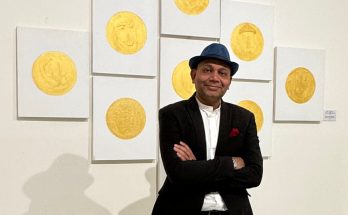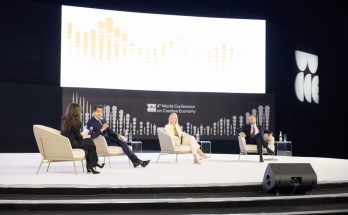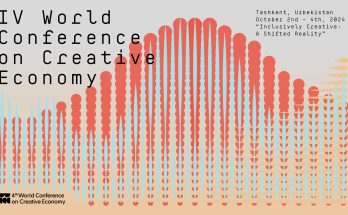During its G20 presidency, India successfully highlighted its diverse cultural heritage, including performing arts, visual arts, heritage sites, and culinary traditions, serving as a testament to the country’s cultural richness and promoting cross-cultural understanding among member nations. India’s G20 presidency has not only projected its cultural soft power, but also its economic potential in the cultural and tourism sectors, making it a source of national pride, highlights Abhay K.
In a world that thrives on divisiveness, India has embodied the spirit of oneness during its G20 presidency by upholding the ancient Indian philosophy of Vasudhaiva Kutumbakam and its extension, One Earth, One Family, One Future.
India’s G20 presidency has provided a one-of-a-kind opportunity to showcase the diversity and richness of Indian culture, heritage, art, and hospitality to the world’s 20 largest economies and other invited guest countries.
Culture acts as a cohesive agent for growth and development in international relations. Two Indian philosophies, namely Vasudhaiva Kutumbakam and Atithi Devo Bhava, have always been part of Indian traditions, and these were evident during multiple G20 meetings throughout the year across various Indian states and Union Territories.

India is home to a diverse range of songs, music, dance, theatre, tribal and folk traditions, performing and visual arts, rites and rituals, literature and writings known as the intangible cultural heritage of humanity. Each Indian state boasts rich traditions and art forms.
From December 2022 to the present day, over 50 Indian cities have hosted various G20 meetings. The Indian Council for Cultural Relations (ICCR), in collaboration with the respective state governments, has been entrusted with the responsibility of organising cultural events for the invited G20 delegates. So far, more than 300 cultural programmes have been organised in 139 G-20 meetings, featuring over 17,000 artistes from various parts of India.
During India’s G20 presidency, cultural diplomacy fostered better understanding and collaboration among the member countries. Cultural events, exhibitions, and performances organised during G20 meetings created informal and convivial spaces for discussions and relationship-building.
 India is known for its cultural diversity, encompassing languages, traditions, arts and cuisines. The G20 presidency provided an opportunity for India to showcase this diversity and promote cross-cultural understanding among member countries.
India is known for its cultural diversity, encompassing languages, traditions, arts and cuisines. The G20 presidency provided an opportunity for India to showcase this diversity and promote cross-cultural understanding among member countries.
India’s G20 presidency has also fostered collaborations between artistes, musicians, writers and filmmakers from different countries, promoting cross-cultural understanding and creative synergy.
India’s cultural, creative, and tourism industries make significant contributions to its economy. During its G20 presidency, India has emphasised the economic potential of its cultural and tourism sectors and discussed how these sectors can serve as major drivers for economic growth and job creation. By showcasing cultural landmarks, historical sites, and vibrant cities, India aims to attract more tourists, thereby promoting its tourism sector.
During its G20 presidency, India has proudly demonstrated its rich and diverse cultural treasures, a source of pride for every citizen of the country.
Performing Arts
A series of classical, folk, and tribal dances and music reflects India’s multicultural and pluralistic society. India’s rich cultural tapestry is interwoven with an array of classical and folk dance forms, each bearing witness to the nation’s artistic and traditional heritage. Among the distinguished classical dances are Kathak, Odissi, Manipuri, Sattriya, Kuchipudi, Bharatanatyam, Mohiniattam and Kathakali. Recently, during the G20 meetings, these eight classical dance forms took center stage, presenting India’s cultural diversity.
The captivating performances underscored the nation’s vibrant artistic legacy, with each dance form exuding its own unique flavour and narrative. Beyond the classical forms, Indian states came alive with a plethora of folk dances, providing a glimpse into the heart of each state’s customs and ethos. For instance, Maharashtra showcased Lavani, while Punjab presented the spirited Bhangra and graceful Gidda. Gujarat displayed the energetic Garba and Maniyaro, Karnataka featured Dollu Kunitha and Veeragase, and Telangana highlighted Perini Natyam. Kerala added its vivacious Thira and Pulikali to the mix.
The Bihu dance of Assam, encompassing Mising, Bodo, Dimasa, Karbi, Rabha and Hajong, along with the myriad indigenous tribal dances of Nagaland, Jharkhand, Manipur and Arunachal Pradesh, further enriched this colourful tapestry.
Every dance form is a living embodiment of the artistic finesse and cultural depth of each region. These artistic expressions collectively weave the fabric of India’s cultural identity, offering a glimpse into the intricate tapestry of traditions and narratives that grace each state.
Amidst the grandeur of the G20 meetings, a symphony of captivating cultural performances tickled the senses of the delegates. The stage came alive with a harmonious blend of traditions as the attendees were enthralled by a medley of traditional and contemporary melodies, folkloric tunes, indigenous rhythms, and innovative fusions, meticulously orchestrated by well-known musicians.
The musical panorama presented a kaleidoscope of acoustic wonders, a testament to the vastness of India’s musical heritage. These performances were not just harmonies; they were stories told through melodies, a cultural bridge connecting the past and present. Among these renditions, the audience was treated to ethereal and rare instrumental music, transporting them to realms of sonic novelty. In this aural celebration, the delegates were given a taste of India’s musical legacy, each note resonating with the essence of a thousand tales. The performances stood as a vibrant mosaic of cultural narratives, uniting tradition with innovation and leaving an indelible imprint on the collective memory of the G20 guests.
Visual Arts
Visual arts and artistic interpretation, including paintings, sculptures, art installations, and literature, are considered valuable treasures of India and constitute a salient part of Indian culture. During the meetings of the G20 presidency, India presented art exhibitions featuring great masters as well as folk traditions. The exhibits were not limited solely to visual arts but also included other artistic forms such as handloom, rangoli, and handicrafts from various states. Jal Sanjhi, presented in Rajasthan and Hyderabad, was an epic example of water-based art forms. Sand art and mandala art, exhibited in Karnataka, Gujarat and Ladakh, received high praise from the delegates of the G20 member countries.
Contemporary and great artworks, comprising paintings, sculptures, and multimedia installations, were displayed at some of the meeting venues. Works by prominent Indian artists such as Jamini Roy, Rabindranath Tagore, Nandalal Bose, Subodh Gupta, MF Hussain, SH Raza, and Jayashree Burman were presented and exhibited.
Folk and tribal art, including Madhubani, Warli, Phad, Kalamkari, etc, were also showcased, featuring a diverse range of Indian traditional artworks that explore the vibrant array of colours, textures and cultural symbolism unique to the country.
Heritage Sites

India is home to numerous UNESCO World Heritage Sites. The G20 presidency organised visits to some of these iconic sites, offering delegates the opportunity to experience India’s rich architectural wonders firsthand. Cultural diplomacy is a unique way to further economic benefits for the state and boost tourism. In the excursions curated for the delegates, India was able to showcase both its architectural heritage and its diversity in landscapes.
The sites included the shikara ride on the iconic Dal Lake in Kashmir, Loktak Lake in Manipur, the backwaters in Kerala, the Ajanta and Ellora Caves in Maharashtra, Kumbhalgarh Fort in Rajasthan, the Sandbar Brahmaputra Islands in Assam, and a river cruise at Babughat in Kolkata, to name a few. Delegates even witnessed the Ganga aarti in Varanasi and Chapchar Kut (the Harvest festival) in Mizoram.
The broad spectrum of heritage experiences included staying in Kutch’s Tent City in Gujarat and visits to the temples in Mahabalipuram in Tamil Nadu, Khajuraho in Madhya Pradesh, and Konark in Odisha. The attendees witnessed a wide range of native flora and fauna from various parts of India, from the red panda and orchids in Sikkim to the coconut trees in the south. Even the majestic Himalayas, Bay of Bengal, and the Arabian Sea served as backdrops to numerous cultural events that highlighted the magnificence of our nation.
Gastronomy and Culture
Culinary experience is unquestionably an excellent way to navigate and understand one’s culture. The G20 events offered a culinary treat to the delegates with a wide range of mouthwatering regional dishes, taking them on a tour of India’s diverse food culture. G20 delegates had the opportunity to savour Indian cuisine from various regions, such as daal baati and churma from Rajasthan, makki di roti and sarson da saag from Punjab, fish-based curries from the coastal regions of the country, and fermented bamboo dishes from Arunachal Pradesh. The Year of the Millet was showcased in the regional dishes, highlighting its importance in Indian culinary traditions. Various cooking demonstrations and cultural evenings featuring traditional dishes from various seasons gave the delegates a taste of the Indian culinary delights.
Soft Power
India’s presidency of the G20 provided it with a platform to showcase a whole spectrum of Indian culture and India as a premium destination for tourism. It was the first time G20 events were hosted in each and every state and union territory of India, providing each of them with the opportunity to showcase the best of their culture. India’s G20 presidency
has emerged as a source of national pride, with India demonstrating the richness and diversity of its culture to an international audience, thereby projecting its soft power globally.
Abhay K is the author of a dozen collections of poetry and the editor of The Book of Bihari Literature. His poem-song Earth Anthem has been translated into over 150 languages. He received the SAARC Literature Award 2013.
This article has been published in the G20 Summit Edition of India and the World magazine-journal, edited by Manish Chand. To subscribe or buy, write to: indiawritesgroup@gmail.com
Author Profile
- India Writes Network (www.indiawrites.org) is an emerging think tank and a media-publishing company focused on international affairs & the India Story. Centre for Global India Insights is the research arm of India Writes Network. To subscribe to India and the World, write to editor@indiawrites.org. A venture of TGII Media Private Limited, a leading media, publishing and consultancy company, IWN has carved a niche for balanced and exhaustive reporting and analysis of international affairs. Eminent personalities, politicians, diplomats, authors, strategy gurus and news-makers have contributed to India Writes Network, as also “India and the World,” a magazine focused on global affairs.
Latest entries
 India and the WorldJune 26, 2025Operation Sindoor: India Sheds Restraint, Rediscovers Utility of Force
India and the WorldJune 26, 2025Operation Sindoor: India Sheds Restraint, Rediscovers Utility of Force India and the WorldJune 23, 2025BRICS summit in Rio to focus on Global South, local currency trade
India and the WorldJune 23, 2025BRICS summit in Rio to focus on Global South, local currency trade Africa InsightsJune 11, 2025New Opportunities in India-Japan Cooperation in Africa
Africa InsightsJune 11, 2025New Opportunities in India-Japan Cooperation in Africa India and the WorldMay 23, 2025Post-Operation Sindoor, India reminds Turkey, China of concerns and sensitivities
India and the WorldMay 23, 2025Post-Operation Sindoor, India reminds Turkey, China of concerns and sensitivities








